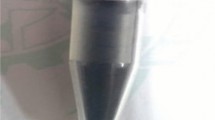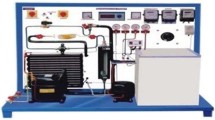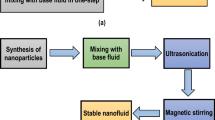Abstract
An experimental study has been carried out to investigate the performance characteristics of a nano-refrigerant in a vapor compression refrigeration system. Experiments are conducted for two different fluids: (i) pure hydrocarbon (HC) refrigerant and (ii) nano-refrigerant. In this study, different concentrations of CuO nanoparticles (0.2, 0.3 and 0.4 g) were added in the base refrigerant. In order to conduct the experiments, some of the parameters were varied such as (i) heat supplied from 25 ~ 26 °C, (ii) heat supplied from 35 ~ 36 °C. A significant enhancement in coefficient of performance (COP) is observed which is maximum with nanoparticles concentration of 0.4 g. The cooling speed becomes relatively higher compared to the base refrigerant and is found to be increasing with rise in nanoparticles concentration. In addition, this study also identifies the difficulties and scope for future research. These results may be also used in commercial refrigerators.
Access this chapter
Tax calculation will be finalised at checkout
Purchases are for personal use only
Similar content being viewed by others
References
Akhavan-Behabadi, M. A., Sadoughi, M. K., Darzi, M., et al. (2015). Experimental study on heat transfer characteristics of R600a/POE/CuO nano-refrigerant flow condensation. Experimental Thermal and Fluid Science, 66, 46–52.
Alawi, O. A., & Sidik, N. A. C. (2015). The effect of temperature and particles concentration on the determination of thermo and physical properties of SWCNT-nano-refrigerant. International Communications in Heat and Mass Transfer, 67, 8–13.
Alawi, O. A., & Sidik, N. A. C. (2014). Influence of particle concentration and temperature on the thermophysical properties of CuO/R134a nano-refrigerant. International Communications in Heat and Mass Transfer, 58, 79–84.
Zawawi, N. N. M., Sharif, M. Z., et al. (2017). Thermo-physical properties of Al2O3-SiO2/PAG composite nanolubricant for refrigeration system. International Journal of Refrigeration, 80, 1–10.
Pinto, R. V., & Fiorelli, F. A. S. (2016). Review of the mechanisms responsible for heat transfer enhancement using nanofluids. Applied Thermal Engineering, 108, 720–739.
Li, H., Yang, W., Zhixin, Y., & Zhao, L. (2015). The performance of a heat pump using nanofluid (R22 + TiO2) as the working fluid – an experimental study. Energy Procedia, 75, 1838–1843.
Azmi, W. H., Sharif, M. Z., et al. (2017). Potential of nanorefrigerant and nanolubricant on energy saving in refrigeration system – A review. Renewable and Sustainable Energy Reviews, 69, 415–428.
Yang, L., Jiang, W., et al. (2017). Dynamic characteristics of an environment-friendly refrigerant: Ammonia-water based TiO2 nanofluids. International Journal of Refrigeration, 82, 366–380.
Manoj Babu, A., Nallusamy, S., & Rajan, K. (2015). Experimental analysis on vapour compression refrigeration system using nanolubricant with HFC-134a refrigerant. Nano Hybrids, 9, 2234–9871.
Bi, S., Shi, L., & Zhang, L. (2008). Application of nanoparticles in domestic refrigerators. Applied Thermal Engineering, 28, 1834–1843.
Huminic, G., Huminic, A., Morjan, I., & Dumitrache, F. (2011). Experimental study of the thermal performance of thermosyphon heat pipe using iron oxide nanoparticles. International Journal of Heat and Mass Transfer, 54, 656–661.
Lin, L., Peng, H., & Ding, G. (2016). Experimental research on particle aggregation behaviour. In nano refrigerant–oil mixture. Applied Thermal Engineering, 98, 944–953.
Mahbubula, I. M., Saidur, R., & Amalina, M. A. (2013). Thermal conductivity, viscosity and density of R141b refrigerant based nanofluid. Procedia Engineering, 56, 310–315.
Yang, L., & Kai, D. (2013). An optimizing method for preparing natural refrigerant: Ammonia-water nano fluids. An International Journal, 147(1), 24–33.
Xing, M., Yu, J., & Wang, R. (2015). Application of fullerene C60 nano-oil for performance enhancement of domestic refrigerator compressors. International Journal of Refrigeration, 40, 398–403.
Author information
Authors and Affiliations
Corresponding author
Editor information
Editors and Affiliations
Rights and permissions
Copyright information
© 2021 The Author(s), under exclusive license to Springer Nature Singapore Pte Ltd.
About this paper
Cite this paper
Kaushik, R., Sharma, R.K., Kalsia, M., Lal, K. (2021). Experimental Analysis of Hydrocarbon Refrigerant and CuO Nano-Particles Based Vapour Compression System. In: Sharma, B.P., Rao, G.S., Gupta, S., Gupta, P., Prasad, A. (eds) Advances in Engineering Materials . Lecture Notes in Mechanical Engineering. Springer, Singapore. https://doi.org/10.1007/978-981-33-6029-7_8
Download citation
DOI: https://doi.org/10.1007/978-981-33-6029-7_8
Published:
Publisher Name: Springer, Singapore
Print ISBN: 978-981-33-6028-0
Online ISBN: 978-981-33-6029-7
eBook Packages: EngineeringEngineering (R0)




